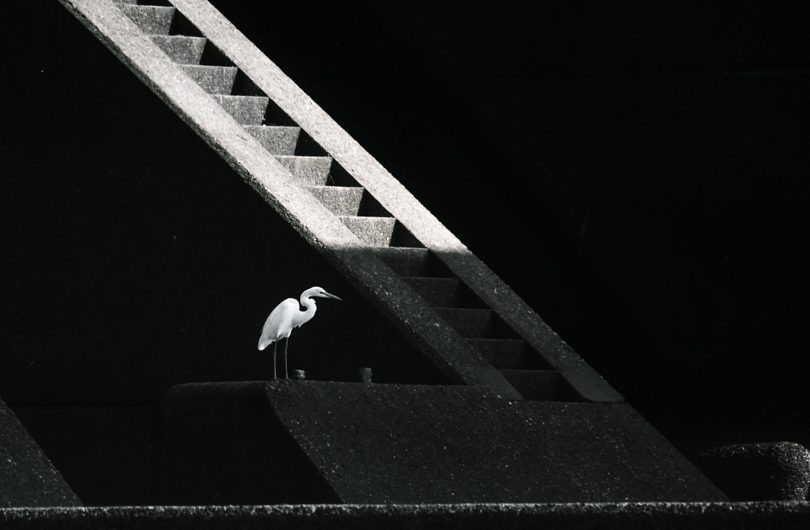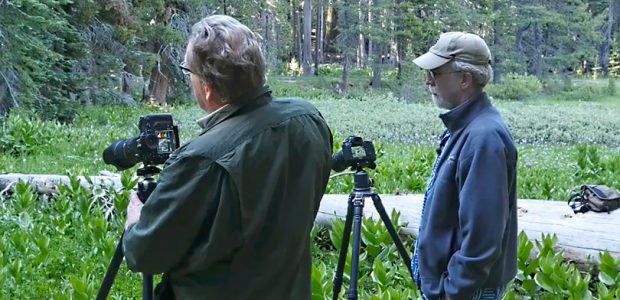

The Southern Exposure Grant – Paula Van Every – Grant Value – 2,500
Background
The primary goal of the Dam Bird project was to raise public awareness about a community of water birds living beneath a suburban dam that controls water flow into the lower Pearl River. I was captivated by the beauty of these delicate birds even in the squalor and ever-changing water conditions within the corroding underbelly of the dam. I worried about the risks to the birds from the excessive litter I saw down there, especially after I saw a great blue heron choke on a fishing lure and days later found his body on the rocks.
I wanted to tell the story of these birds in images but I didn’t want to use the typical approach of documenting the ugliness and dangers graphically enough to shock viewers into action. I wanted instead to use a fine art approach to emphasize the birds’ delicate grace against the looming industrial structure they shared with local fishermen, and focus on the beauty that transcends the ugliness and danger. I wanted the images to inspire people to become interested in the birds and the other creatures of the lower Pearl River, and perhaps to take action to protect this fragile watershed.


A Year With The Dam Birds: Story of the Southern Exposure Grant
Though I’d been photographing the birds for a year before the LULA award, I had no clear path established for how to make the images public. Receiving the award propelled me into charting that path. There were roadblocks and detours, but there were also wonderful and unexpected avenues that opened up.
I started my adventure by contacting the manager of the Water Supply District, to seek his support and hopefully get advice. He shared his own frustration about the litter problem. He put me in touch with a retired watershed analyst who was starting a cleanup project beneath the dam, under the auspices of the local chapter of Keep America Beautiful. In short order, I became a volunteer, spending as much time picking up litter and talking to fishermen as I did taking photos. Later, I became the official photographer for the KAB chapter and was appointed to their board of directors. On our focus weekend during September, over 1000 volunteers brought 18 tons of garbage out of the Pearl River across two states. Our KAB chapter has spun off two new initiatives led by volunteers from the dam cleanups: the Reservoir Fishing Group has assumed ongoing oversight of litter control under the dam and Pearl Riverkeeper is overseeing the cleanup of the entire Pearl River. These new entities are active in a wide variety of community service and ecological activism efforts including litter control and water purity.
Since this was my first foray into bird photography, I turned to the local Audubon chapter for help identifying the birds and understanding their behaviors. From them, I learned how courageous my birds really are. Great blue herons and great egrets do not dive for food. They are shorebirds and fish while wading in shallows. Yet, the Dam Birds do indeed dive. They have adapted to the environment they have chosen by learning to dive into water so tumultuous that boats are allowed nowhere near it.


While working on these projects, I continued to shoot new dam bird images with my regular equipment – my Olympus EM1, a 75-300 kit telephoto and a high-quality legacy 50-200 lens with an adapter. A Belgian photographer who saw my images online gifted me with an interesting 400mm lens to enable me to take different kinds of images.

Next came the challenge of how to recruit a display opportunity. As my photo collection grew I made an online website to showcase the latest birds and a portfolio of prints to use while seeking exhibit opportunities. Once I began to make contacts through the environmental projects, surprising doors opened. One contact would lead to another. If I ran into a “no thank you”, as I did with the local airport gallery, I just consulted my contact list and got a new lead. I learned that there may be more than one destination and more than one route to it.
In July the Mississippi Museum of Natural Science invited me to have my opening show in their wonderful facility, and in their prime exhibit space. I created a private online gallery of 50 of my best offerings for the administrators of the museum to select 15 images from.
With support from online acquaintances from as far away as Australia, I learned how to prepare the selected images for large fine art prints, uncharted territory for me. A local print company did the printing, matting, and framing. We chose Hahnemuhle German Etching paper to give the images a painterly look that fit the processing approach.


My exhibit opened Aug. 31, 2017. Though Birds of the Dam was supposed to be displayed for 30 days, the directors liked it so much that they extended it through Dec. 31, allowing the collection to be seen by thousands of visitors from all over the world. The local KAB chapter sponsored an opening gala, a wonderful celebration for all those working on the dam project. The event was covered by two large newspapers, both of which published features. Links to the articles: Clarion-Ledger here and the Jackson Free Press here.


On February 1, Birds of the Dam opened in the gallery of the Chastaine-Flynt public library, only 2 miles from the dam itself, and they are still on display there. This is a large multipurpose facility housing many community activities, making the display available to a large and varied audience.
Most of the grant award was spent on the printing, matting and framing of the 15 images. Other expenditures included printing costs for the brochures, cards, posters, and other supplies for the exhibits, costs for the demonstration portfolio and test printing. The grant also covered travel costs to photograph the birds, to galleries about possible or planned exhibits, and to maintain contact with the exhibit coordinators on-site. I had hoped to stretch the money further for even more displayable prints, but the 15 have served me well.

Next Steps
Birds of the Dam will remain at Chastaine-Flynt this summer. I am in conversations with a library in a nearby city and with the Audubon gallery in Pascagoula about hosting the exhibit in the fall and into 2019. The Science Museum has expressed a desire to host another exhibit of my new collection featuring a Mississippi swamp in all seasons. I will seek funding sources to help defray the costs of putting together the new grouping. Science Museum staff are also interested in hosting a panel discussion about the adaptive behaviors of the dam birds. I will remain a volunteer and official photographer for the KAB chapter. Tomorrow I will start a new assignment about a project to assist disabled adults, especially disabled veterans, to access water-based recreation. And of course, I will continue to add to the Dam Bird collection and experiment with new ways to create images of them.


Conclusions
The Year With the Dam Birds has been fraught with challenges and victories. Every challenge led to new knowledge. I gained a lot of technical know-how: I learned how to upsize images for large prints and posters, how to select proper paper for a particular kind of image, how to prepare a press release, how to design promotional materials, how to make a portfolio, how to give an interview, even how to take a selfie headshot. I also learned some “not’s”: what kinds of frames and glass not to buy, what kinds of color spaces not to use when outsourcing to a printer.
But the biggest and most valuable lessons were about project engagement. My best advice to others is: if you want to complete a photography project, choose one that you have passion about and then get your hands dirty. Contribute to the cause you want to turn into art. If I had stood alone on the bank of the Pearl, I would have continued to make images of these magical birds. By getting involved in the work, I not only gained wonderful opportunities for my images to be seen by thousands of people, but I also have the satisfaction of having contributed to the ongoing protection of these and other birds of this 8760 square mile watershed. My greatest satisfaction is that I’ve been a conduit to allow the birds to tell their own story to so many people.


Geometry Two
Paula Van Every
September 2018
You May Also Enjoy...
Shooting With The Masters – William Neill – On Location Part 2
Enjoy Part 2 On Location With William Neill - Shooting With The Masters William Neill and I continue our photo tour in Yosemite National Park. In this
January Moonset SMA
Please use your browser's BACK button to return to the page that brought you here.


